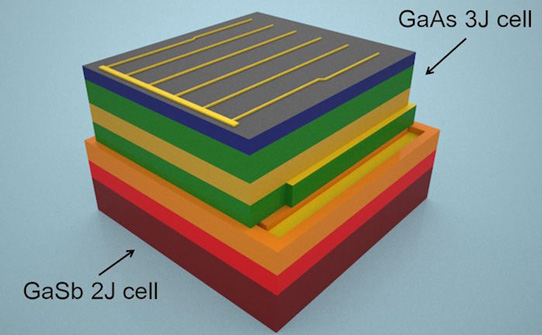- News
19 July 2017
Five-junction solar cell yields module efficiency of 41.2%
A research team at the George Washington University, US Naval Research Laboratory, Sotera Defense Solutions of Annapolis Junction, MD, USA, Semprius Inc, Durham, NC, USA and University of Illinois Urbana-Champaign has designed and constructed a prototype solar cell that integrates multiple cells stacked into a single device capable of capturing nearly all of the energy in the solar spectrum (Matthew P. Lumb et al, ‘GaSb-based Solar Cells for Full Solar Spectrum Energy Harvesting’, Advanced Energy Materials (2017); doi: 10.1002/aenm.201700345). The new design has solar energy conversion efficiency of 44.5%, giving it the potential for record solar cell efficiency, it is reckoned.
The new device uses concentrator photovoltaics (CPV), employing lenses to concentrate sunlight onto micro-scale solar cells. Because of their small size — less than 1mm2 — solar cells utilizing more sophisticated materials can be developed cost effectively.
In the stacked cell, tailored materials in each layer absorb the energy of a specific set of wavelengths. By the time the light is funneled through the stack, just under half of the available energy has been converted into electricity (compared with only a quarter for the most common solar cells currently).
“Around 99% of the power contained in direct sunlight reaching the surface of Earth falls between wavelengths of 250nm and 2500nm, but conventional materials for high-efficiency multi-junction solar cells cannot capture this entire spectral range,” notes lead author Matthew Lumb, a research scientist in George Washington University’s School of Engineering and Applied Science. “Our new device is able to unlock the energy stored in the long-wavelength photons, which are lost in conventional solar cells, and therefore provides a pathway to realizing the ultimate multi-junction solar cell.”
The new cell is claimed to have two novel aspects. First, it uses materials based on gallium antimonide (GaSb) substrates (which are usually found in applications for infrared lasers and photodetectors). The dual-junction GaSb/InGaAsSb concentrator solar cell – which can efficiently convert the long-wavelength photons that are typically lost in a multi-junction solar cell – has had its performance optimized via a combination of modeling and experimental device development. This cell is assembled into a stacked structure along with a commercially available high-efficiency GaAs-based triple-junction solar cell grown on conventional substrates that capture shorter-wavelength photons. In addition, the mechanical stacking procedure uses the transfer-printing technique, which enables three-dimensional assembly of the devices with a high degree of precision.

The cell is assembled in a mini-module with a geometric concentration ratio of 744 suns on a two-axis tracking system and demonstrated a combined module efficiency of 41.2%, measured outdoors in Durham, NC. Taking into account the measured transmission of the optics gives an implied cell efficiency of 44.5%.
This particular four-terminal, five-junction solar cell is very expensive. However, the researchers believe it was important to show the upper limit of what is possible in terms of efficiency. Despite the existing costs of the materials involved, the technique used to create the cells shows much promise. Eventually a similar product may be brought to market, enabled by cost reductions from very high solar concentration levels and technology to recycle the expensive growth substrates, it is reckoned.
The research builds on the advances made by the MOSAIC Program, a $24m project funded by the Advanced Research Projects Agency-Energy (ARPA-E) that funds 11 separate teams across the USA, each seeking to develop technologies and concepts to revolutionize photovoltaic performance and reduce costs. The researchers note that funding for this type of research is essential for developing viable commercial technology in the future.
Semprius raises efficiency record for commercially available solar modules from 33.9% to 35.5%
http://onlinelibrary.wiley.com/doi/10.1002/aenm.201700345/abstract


